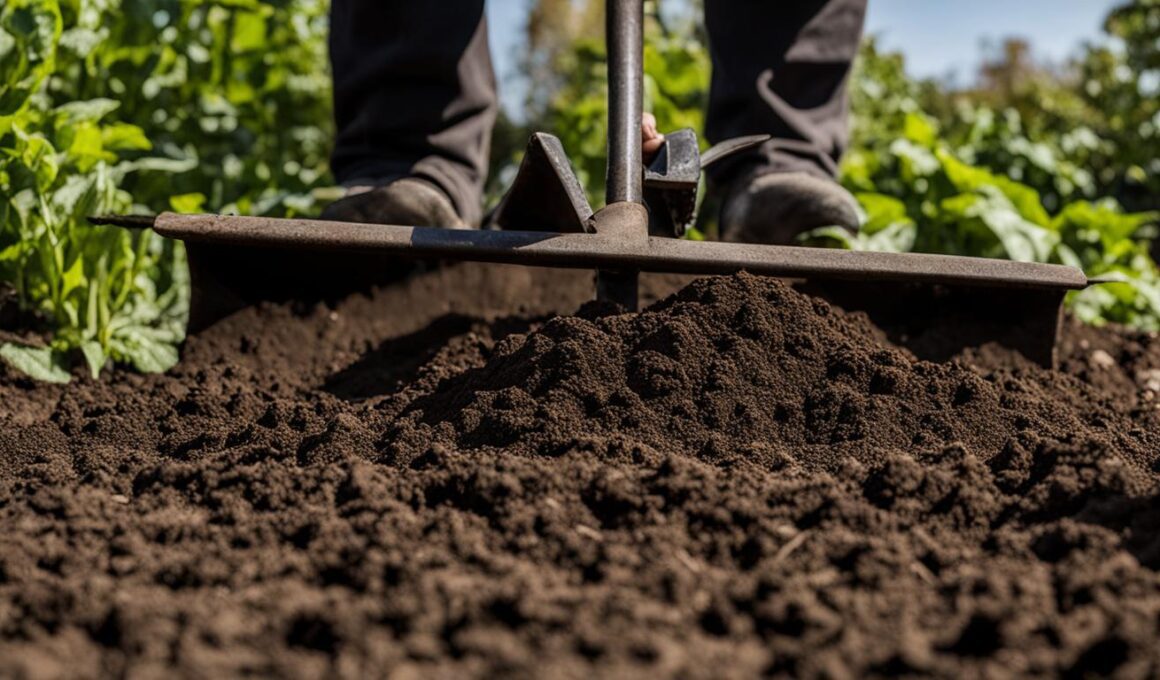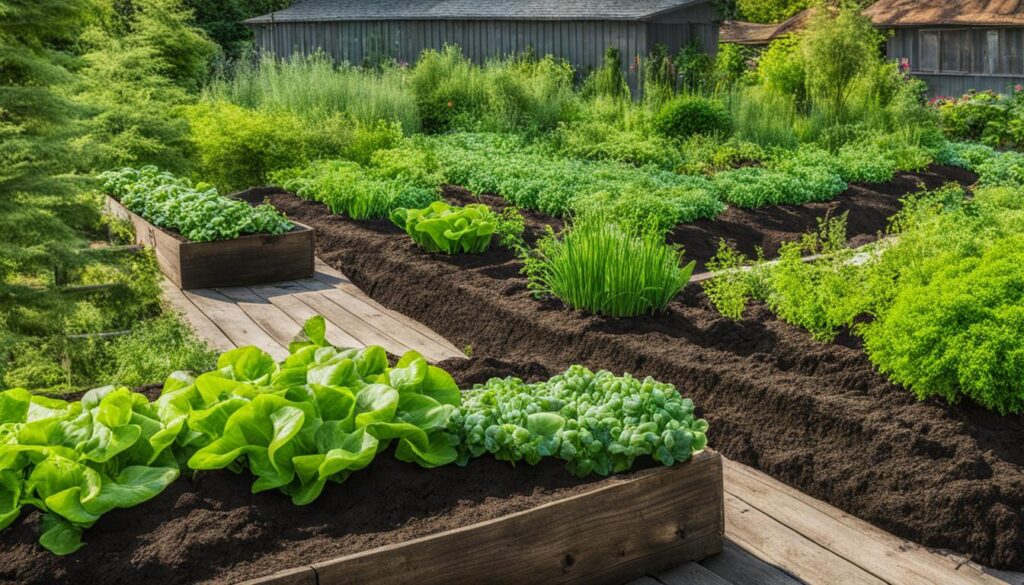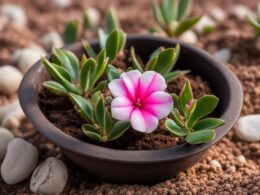Tilling is an essential task for preparing the soil in your garden and ensuring optimal conditions for plant growth. Whether you’re a seasoned gardener or just starting out, learning how to use a tiller can greatly benefit your garden. In this article, we will provide you with valuable tips and insights on using a tiller effectively to make your gardening experience a success.
Before you begin tilling, it’s important to assess the state of your soil. Dry soil is ideal for tilling, as it prevents soil compaction and allows for better root penetration. Adjust the depth regulator on your tiller and start tilling in parallel lines, similar to mowing the lawn. Remember to relax and let the wheels pull the tiller while the tines do the digging. Avoid pushing down on the handlebars or tilling in hard ground to prevent any accidents.
For more detailed tilling tips and techniques, continue reading below.
Tips for Using a Tiller Effectively
When it comes to using a tiller, there are a few essential tips you should keep in mind to ensure effective and efficient tilling. These tips will help you achieve the optimal tilling depth, improve soil aeration, and maintain your garden with ease.
Adjusting the Tilling Depth: The tilling depth plays a crucial role in preparing your soil for planting. If you have dry and compacted soil, set the depth to a shallow level. For soft ground, opt for a medium setting. By adjusting the tilling depth, you ensure that the tiller effectively breaks up the soil for proper aeration.
Creating Parallel Rows: Engage the drive of your tiller and create parallel lines while tilling. This technique ensures even soil preparation and prevents the formation of uneven patches in your garden. Once you finish tilling the rows, adjust the tiller to its deepest depth and create new rows perpendicular to the previous ones. This cross-directional tilling further enhances soil aeration and creates an ideal environment for plants to thrive.
Walking on Untilled Soil: To avoid footprints in the freshly tilled soil, make sure to walk on the side that has not been tilled yet. By doing so, you maintain a neat and well-groomed appearance in your garden.
Depending on the size of your garden, it’s important to choose the right type of tiller. For smaller, established landscape beds, a front-tine tiller is ideal. The front-tine tiller offers excellent maneuverability and is perfect for maintaining existing gardens. On the other hand, if you have a larger area or need to break new ground, a rear-tine tiller is the best option. The rear-tine tiller provides more power and stability, making it suitable for more extensive projects.
Lastly, always exercise caution when operating the tiller on gravel surfaces. Sharp rocks and debris can damage the tiller’s blades. Following the manufacturer’s recommendations for attachments and accessories is crucial to ensure safe and efficient tilling.
Benefits of Tilling and When to Till
Tilling is a crucial step in gardening that offers several benefits for your garden’s overall health and productivity. By understanding the advantages of tilling and knowing the ideal timing for this activity, you can create a thriving garden that flourishes with healthy plants and bountiful harvests.
Improved Soil Fertility
One of the primary benefits of tilling is the enhancement of soil fertility. When you till the soil, it helps to break up compacted layers and loosen the earth, making it easier for plant roots to access essential nutrients. This enhanced nutrient availability promotes robust plant growth, leading to vibrant and productive gardens.
Enhanced Moisture Absorption
Tilling also plays a vital role in improving moisture absorption within the soil. By loosening the soil, water can penetrate more easily, preventing excess runoff and allowing the roots to access moisture effectively. This helps to maintain optimal hydration levels for plants and reduces the risk of water stress, ultimately contributing to healthier and lusher gardens.
Faster Plant Growth
The loosening of the soil through tilling facilitates better aeration and oxygenation, essential for the healthy functioning of plant roots. With improved oxygen availability, plants can undergo cellular respiration and nutrient absorption more efficiently, resulting in faster and healthier growth. Tilling encourages vigorous root development, enabling plants to establish themselves more robustly and thrive in diverse environmental conditions.
Weed Control
Tilling also aids in weed control by uprooting and burying weed seeds present in the soil. When you till the soil, you disrupt the germination and growth of unwanted weeds, helping to effectively manage weed populations in your garden. By incorporating this practice into your gardening routine, you can maintain a weed-free environment and allow your plants to receive the full benefits of soil nutrients and resources.
Optimal Tilling Timing
The timing of tilling is crucial to ensure its effectiveness and minimize potential risks. The best time to till your garden is in the spring when the soil is dry and workable. Aim to till when the soil temperature is around 60°F, as this promotes optimal biological activity and nutrient availability for plants. Avoid tilling in wet soil, as it can lead to compaction and disrupt the soil structure. To determine if the soil is ready for tilling, perform a simple test by picking up a ball of soil – if it crumbles apart when poked, that’s a good indicator that it is dry enough for tilling.
Before you begin tilling, it’s important to remove debris, rocks, and large plant stems from the garden area. This prevents damage to the tiller’s blades and ensures a smoother tilling process. By following these guidelines, you can maximize the benefits of tilling and create an optimal growing environment for your plants.
Conclusion
Using a tiller effectively is crucial for proper garden preparation and maintenance. By following the tips and guidelines mentioned in this article, you can ensure that your tilling process is efficient and safe. Remember to check the state of your soil before tilling, adjust the tilling depth accordingly, and use the proper type of tiller for your garden size.
Tilling offers numerous benefits for your garden, including improved soil fertility, better nutrient absorption, and effective weed control. When you till the soil, you create a loose and well-aerated environment that promotes healthy root growth and enhances the overall health of your plants. Additionally, tilling helps to break up compacted soil, allowing water to penetrate more easily and reducing the risk of water runoff.
To make the most out of your tilling efforts, it’s important to also practice good garden maintenance. Regularly remove any weeds or grass that may have re-emerged after tilling, as they can compete with your plants for nutrients and water. Mulching your garden can also help to retain moisture and suppress weed growth. And don’t forget to water your garden adequately, especially during dry periods.
So, unlock the secret to a thriving garden by using a tiller effectively and boost your gardening success. Whether you’re starting a new garden bed or maintaining an existing one, proper tilling techniques and garden care will ensure that your plants thrive and flourish. Happy gardening!
Are the techniques for using a tiller and a sod cutter similar?
Yes, the techniques for using a tiller and a sod cutter are different. When using a sod cutter, you’ll need to cut through the grass and roots to remove a layer of sod. On the other hand, a tiller is used to break up and prepare the soil for planting.










